Sh’eibiyyat
May 3rd, 2009
Sh’eibiyyat is one of the most favorite sweets in Syria. It is a specialty of Hama, Aleppo, and Idlib. It is prepared from ‘Ajineh Mwarraqah, stuffed with Qasheh “Qeshta” or chopped walnuts, then baked and drizzled with sugar syrup. It is Served as a dessert or for breakfast. In Aleppo, it is served for breakfast with Mamouniyeh.
Let’s make Sh’eibiyyat:
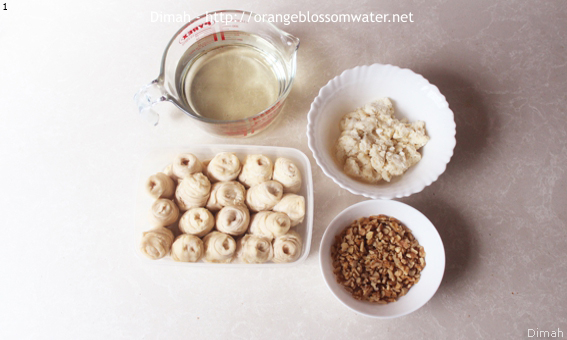
1. Ingredients for Sh’eibiyyat are: ‘Ajineh Mwarraqah, Qasheh “Qeshta”, chopped walnuts, and sugar syrup.
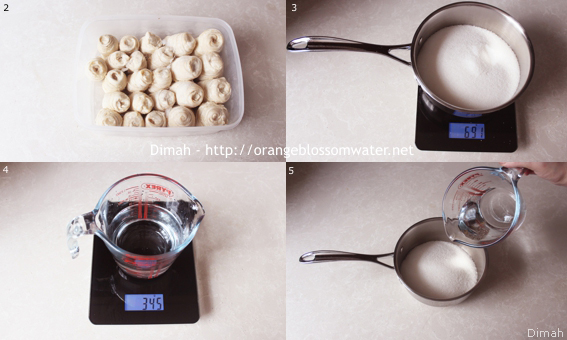
2. Dough is used fresh or frozen, check the post ‘Ajineh Mwarraqah for all the details about it. If it is frozen, allow to thaw in the fridge for few hours then at room temperature. Do not leave it a room temperature for long time, otherwise ghee will melt, the dough should hold its shape. I used two sizes, large Sh’eibiyyat are made with pieces of dough weighs 50 g, small Sh’eibiyyat are made with pieces of dough weigh 25 g.
Sugar Syrup
3. Put 690 g (3 cups) sugar in a saucepan.
4,5. Pour 345 g (1 1/2 cups) water over sugar.
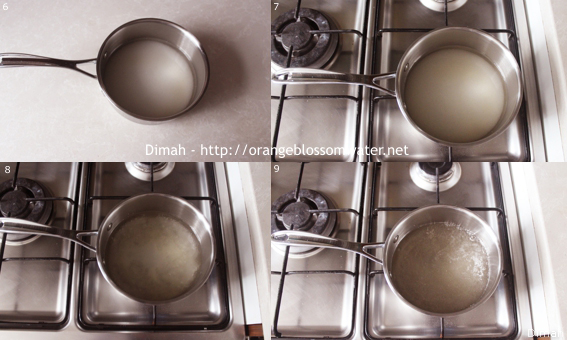
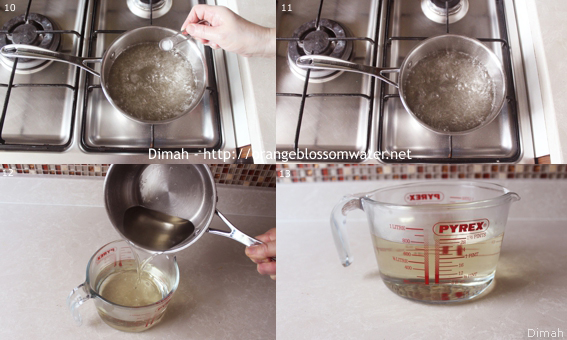
6, 7, 8, 9. Dissolve sugar in water over high heat, and bring it to boil.
10, 11. Add less than 1/8 teaspoon lemon salt (citric acid) or lemon juice to sugar syrup, and boil for 5 minutes.
12, 13. Allow to slightly cool, then pour into a jug and set aside.
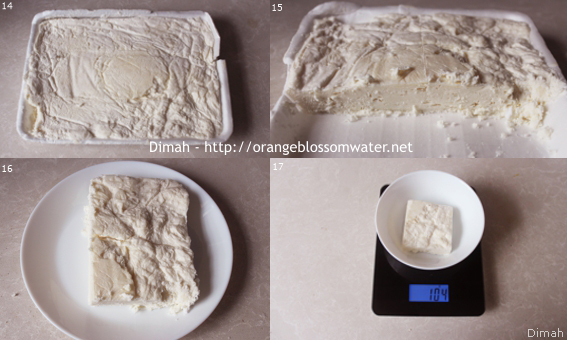
Filling
Qasheh Filling
Sh’eibiyyat is filled with Qasheh “Syrian clotted cream made from sheep’s milk” that is available only in Hama, nothing can substitute the real taste of Qasheh.
14, 15, 16. This is Qasheh, the real Syrian clotted cream.
17. Measure 100 g Qasheh, and set aside.
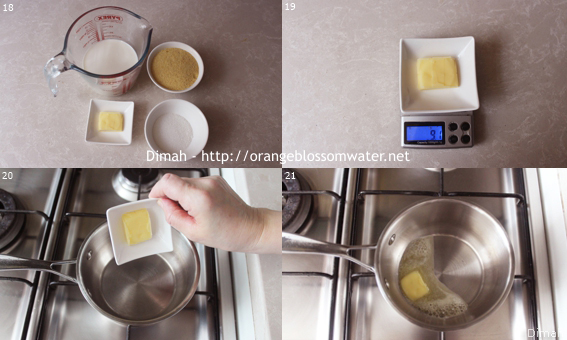
Khabisah
If Qasheh is not available, this is a recipe of “Khabisah” to use it instead of Qasheh, but it won’t give the same taste.
18. Ingredients for Khabisah are: butter, semolina, sugar and milk.
19, 20, 21. Melt 10 g butter.
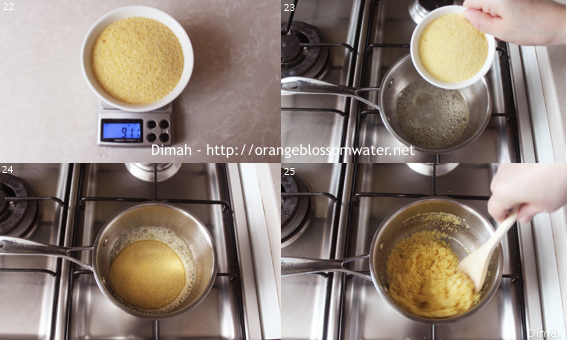
22, 23, 24, 25. Add 90 g (1/2 cup) medium semolina to butter, stir with a wooden spoon until lightly toasted.
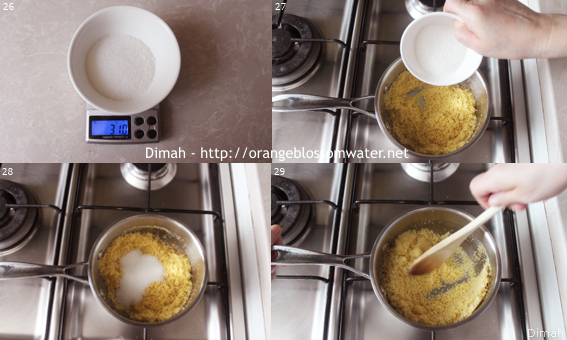
26, 27, 28, 29. Add 30 g (2 tablespoons) sugar to semolina, stir with a wooden spoon.
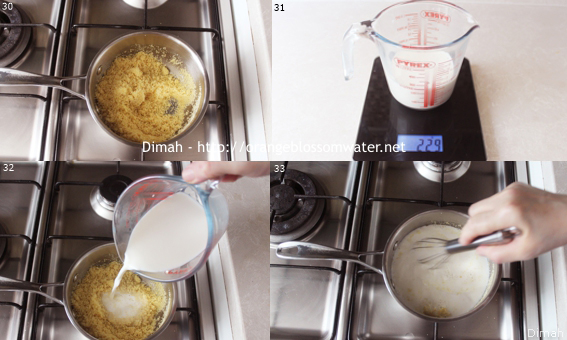
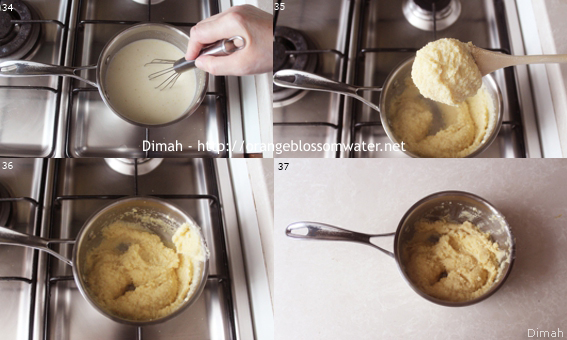
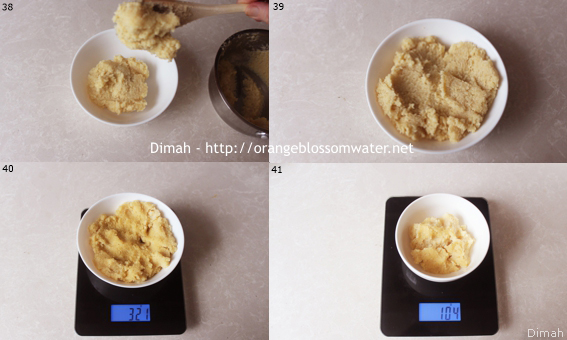
30 to 37. Add 230 g (1 cup) full fat milk to semolina, stir with a whisk until semolina is cooked and thickened.
38, 39. Transfer cooked mixture “Khabisah” to a bowl, allow to completely cool.
40. The total weight of Khabisah is 320 g.
41. For the recipe, measure 100 g khabisah.

For Qasheh as filling, there are three choices:
– Use only Qasheh “Traditional Syrian clotted cream”. The amount for the recipe is 200 g. This is the traditional way. Sh’eibiyyat sold filled with Qasheh only are usually more expensive.
– If Qasheh is not available, use only Khabisah. The amount for the recipe is 200 g.
– If Qasheh is available but to make the filling lighter, use 100 g Qasheh with 100 g Khabisah. I did this.
42, 43, 44. Add 100 g Khabisah to a bowl.
45. Add 100 g Qasheh to Khabisah.
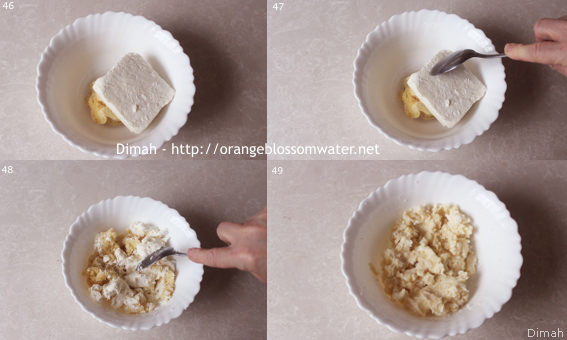
46, 47, 48, 49. Mix the two ingredients together until well combined. This is the first filling for Sh’eibiyyat. Set aside.
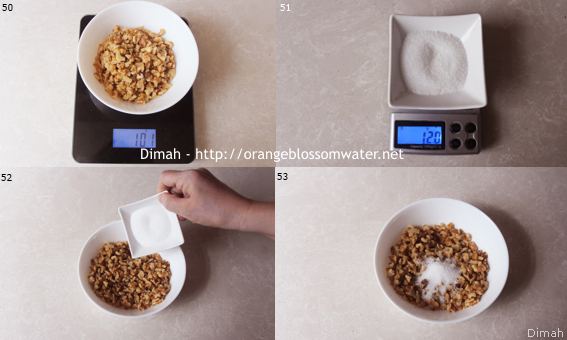
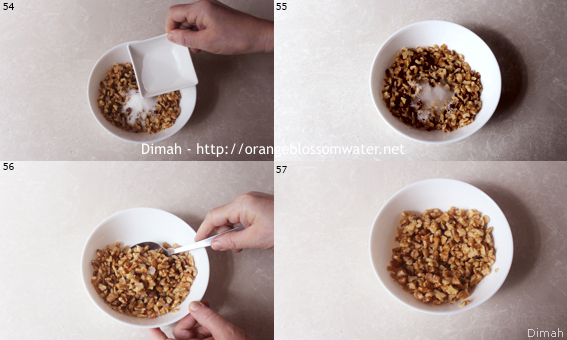
50. Measure 100 g chopped walnuts.
51, 52, 53. Add 12 g sugar to chopped walnuts.
54, 55. Add 5 ml water to walnuts.
56, 57. Mix with a spoon until combined. This is the second filling for Sh’eibiyyat. Set aside.
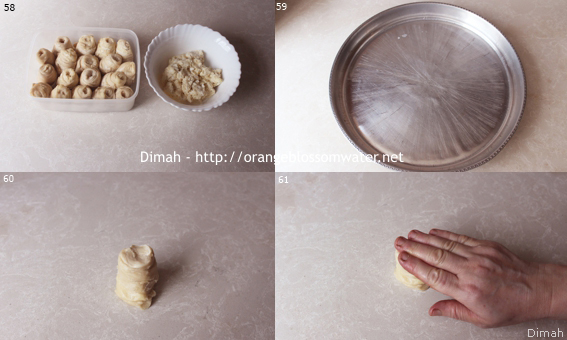
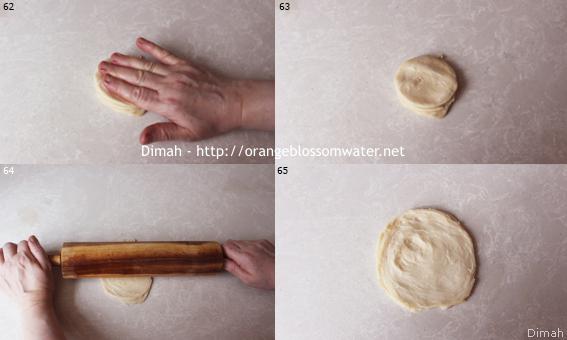
Assembly
58. Bring the dough and the first filling “Qasheh mixed with Khabisah”.
59. Prepare aluminum baking sheet, no need to grease it.
60, 61, 62. Take one piece of dough and gently press with your hand. This piece of dough weighs 50 g.
63, 64, 65. Roll the dough with a rolling pin to a circle about 4.3 inch (11 cm) diameter with 0.2 inch (1/2 cm) thickness.
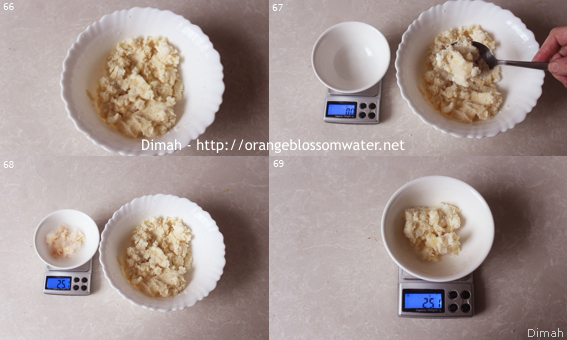
66. Bring the first filling.
67, 68, 69. Each piece of dough that weights 50 g will be filled with 25 g of Qasheh filling.
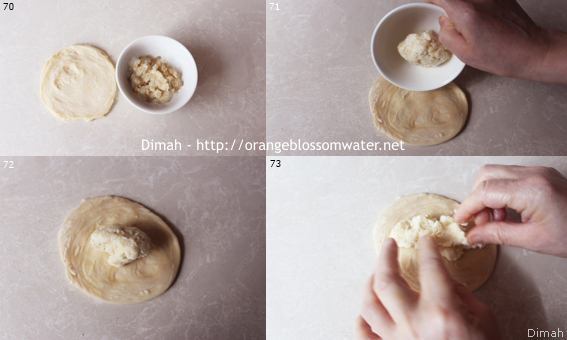
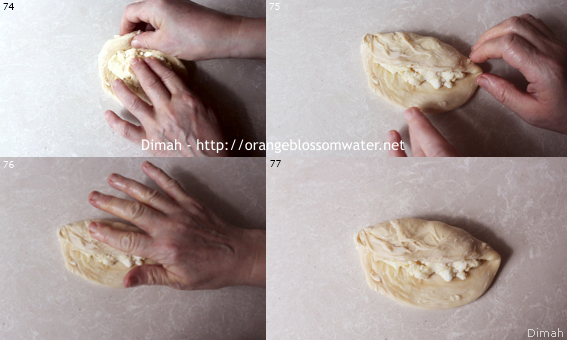
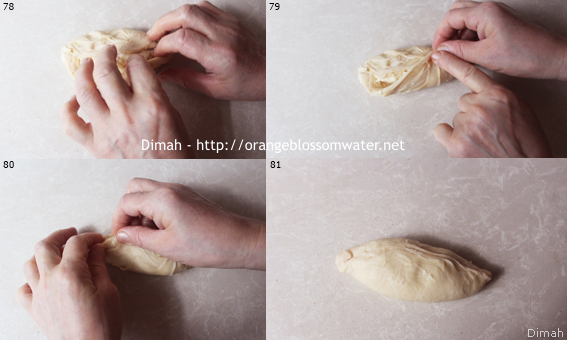
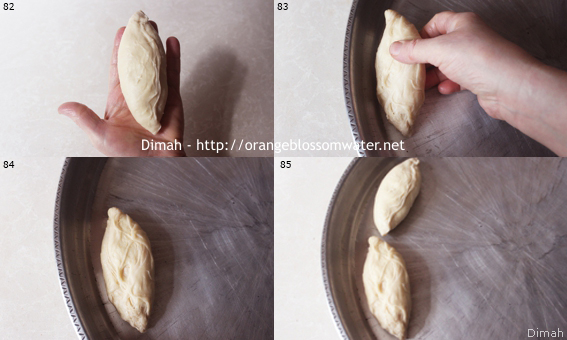
70, 71, 72, 73. Put 25 g filling in the middle of the dough and spread it.
74 to 82. Fold the top of the dough to the middle and the other side over it.
83, 84, 85. Put in the prepared baking sheet.
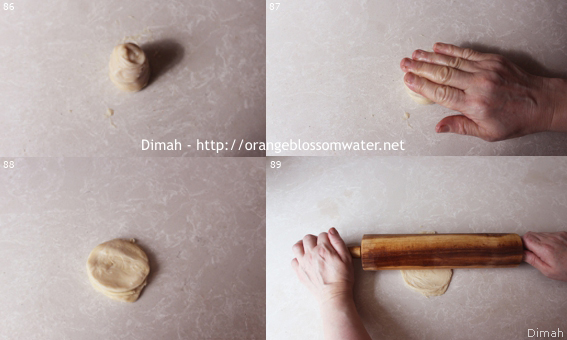

I made Sh’eibiyyat with smaller pieces of dough.
86. Take one piece of dough and gently press with your hand. This piece of dough weighs 35 g.
87, 88, 89, 90. Roll the dough with a rolling pin to a circle 3.5 inch (9 cm) diameter with 0.2 inch (1/2 cm) thickness.
91, 92. Each piece of dough that weights 35 g will be filled with 17 g of Qasheh filling.
93. Put 17 g filling in the middle of the dough and spread it.

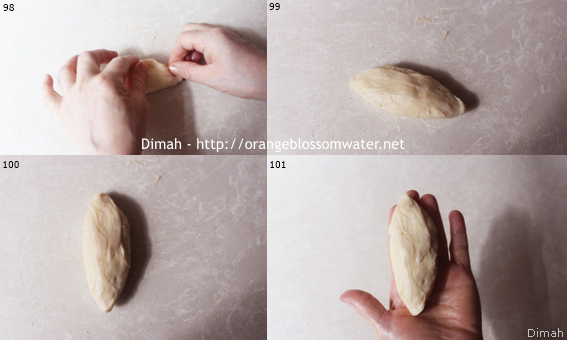
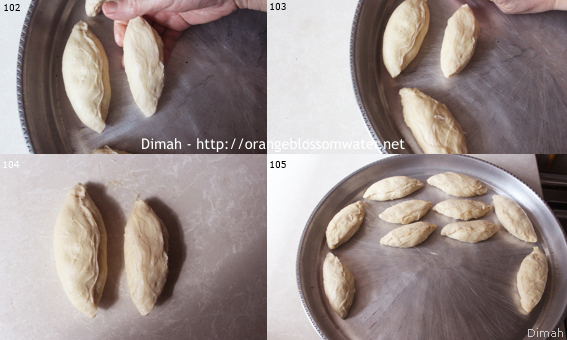
95 to 101 Fold the top of the dough to the middle and the other side over it.
102, 103. Put in the prepared baking sheet.
104. The large piece is on the left, the small piece is on the right.
105. Repeat with the other pieces of dough. I made 6 pieces of dough weigh 50 g and 4 pieces of dough weigh 35 g.
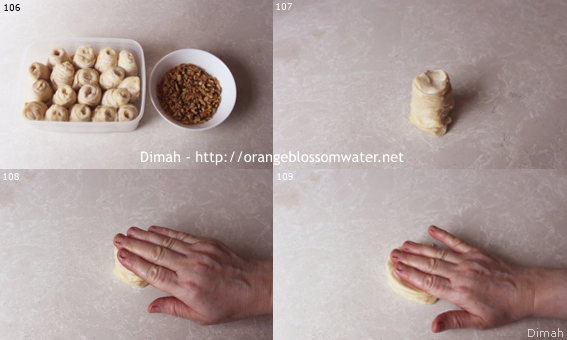
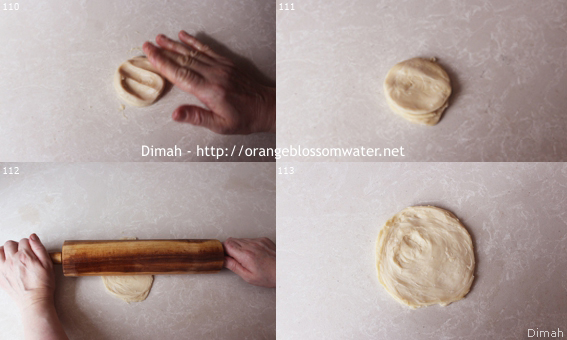
106. Bring the dough and the second filling Chopped Walnuts.
107, 108, 109. Take one piece of dough and gently press with your hand. This piece of dough weighs 50 g.
110, 111, 112, 113. Roll the dough with a rolling pin to a circle about 4.3 inch (11 cm) diameter with 0.2 inch (1/2 cm) thickness.
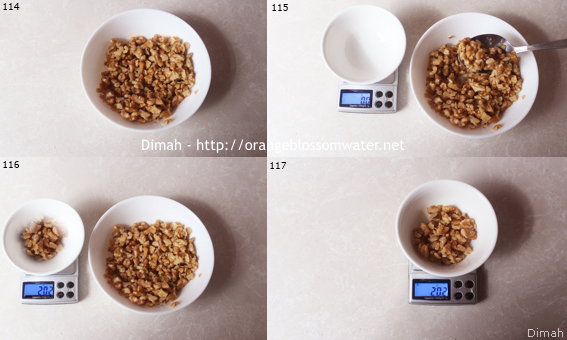
114. Bring the filling.
115, 116, 117. Each piece of dough that weights 50 g will be filled with 20 g of walnuts filling
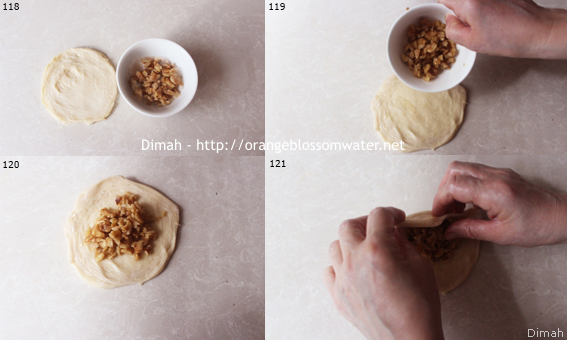
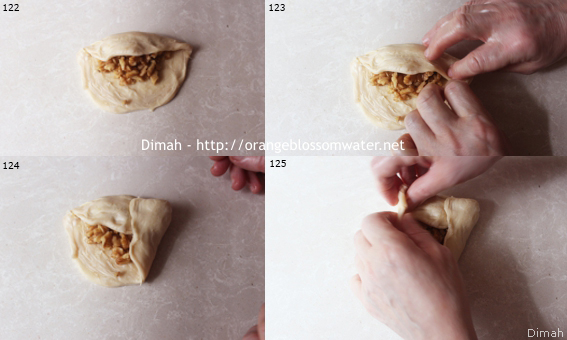
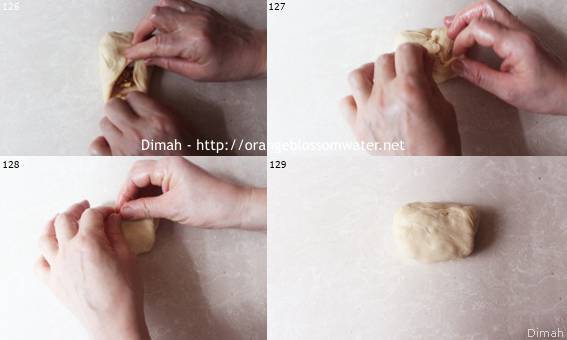
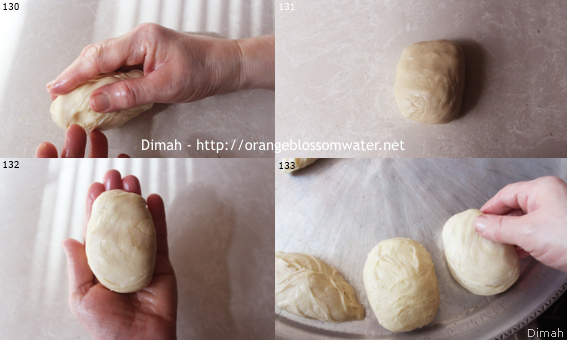
118, 119, 120. Put 20 g filling in the middle of the dough.
121 to 129. Fold the top of the dough to the middle, then the right side, then the left side, then the bottom side over them.
130, 131, 132, 133. Flip the prepared piece over so the seam is down, then put in the prepared baking sheet.

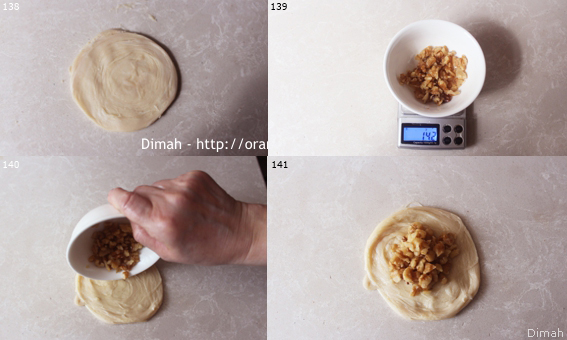
I made Sh’eibiyyat with smaller pieces of dough.
134. Take one piece of dough and gently press with your hand. This piece of dough weighs 35 g.
135, 136, 137, 138. Roll the dough with a rolling pin to a circle 3.5 inch (9 cm) diameter with 0.2 inch (1/2 cm) thickness.
139. Each piece of dough that weights 35 g will be filled with 14 g of walnut filling.
140, 141. Put 20 g filling in the middle of the dough.
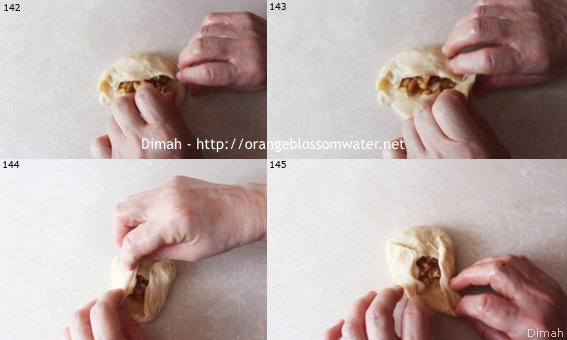
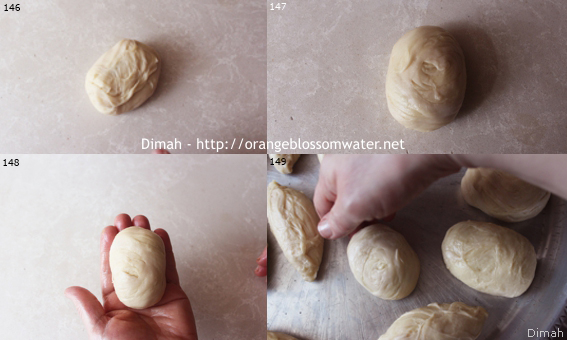
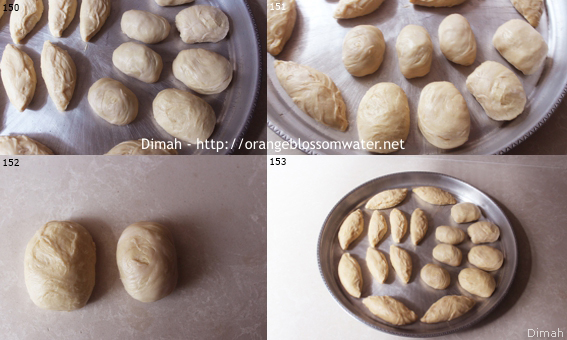
142 to 146. Fold the top of the dough to the middle, then the right side, then the left side, then the bottom side over them.
147, 149, 150, 151. Flip the prepared piece over so the seam is down, then put in the prepared baking sheet.
152. The large piece is on the left, the small piece is on the right.
153. Repeat with the other pieces of dough. I made 4 pieces of dough weighs 50 g and 3 pieces of dough weigh 35 g.
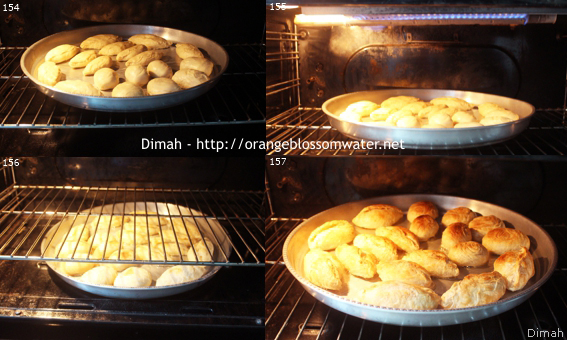
154, 155, 156, 157. Preheat the oven to 428°F (220 °C). Place the baking sheet in the oven (rack position the second from bottom), and bake for 12 minutes or until golden brown in color on bottom. I baked Sh’eibiyyat in the oven with the top burner on and bottom burner on, baked for 7 minutes on second rack from bottom then put it on bottom rack for 3 minutes, then returned to second rack with bottom burner off and kept the top burner on for 2 minutes.

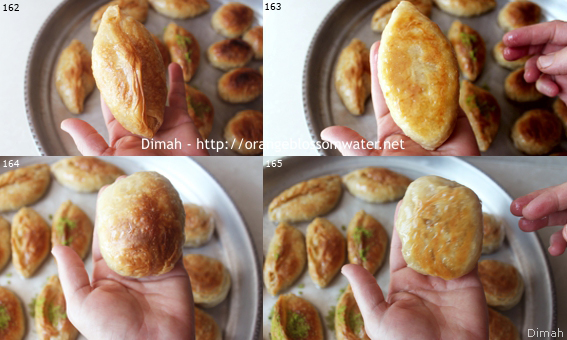
158 t0 165. Take from the oven and keep on the baking.
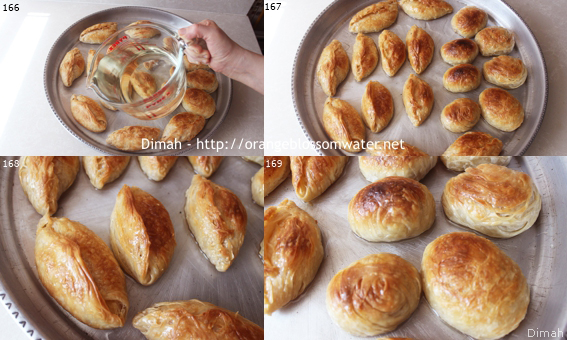
166, 167, 168, 169. Immediately pour cold sugar syrup over them.
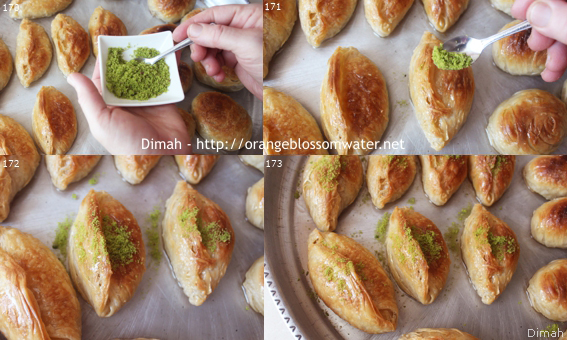
170, 171, 172, 173. Garnish Sh’eibiyyat filled with Qasheh with ground pistachio.
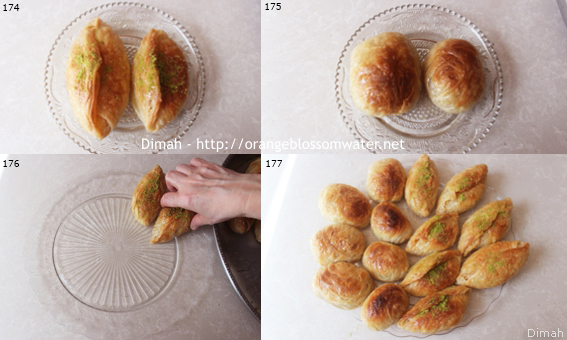
174, 175. The large piece is on the left, the small piece is on the right.
176, 177. Transfer into serving plate.
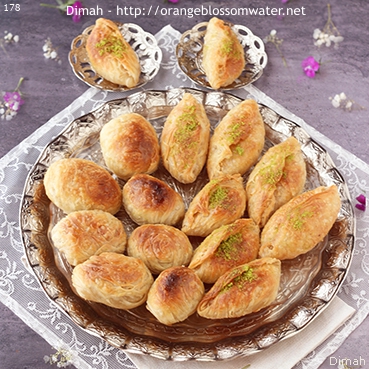
178. Serve Sh’eibiyyat hot, or warm, or at room temperature.

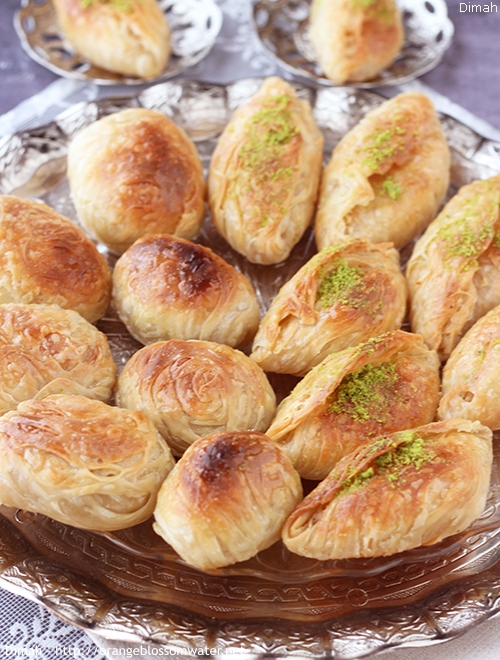
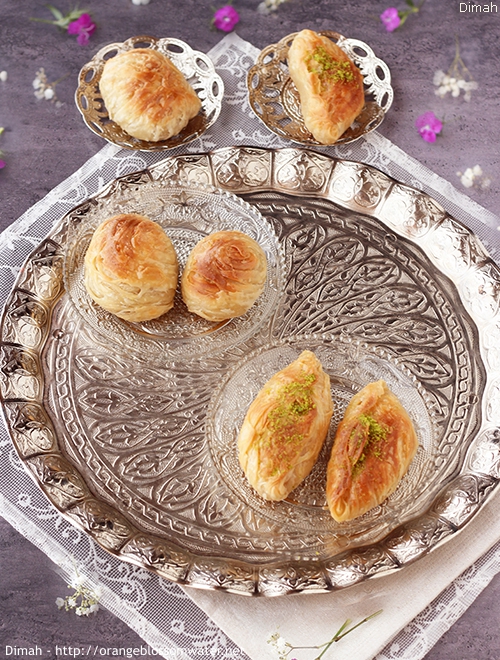
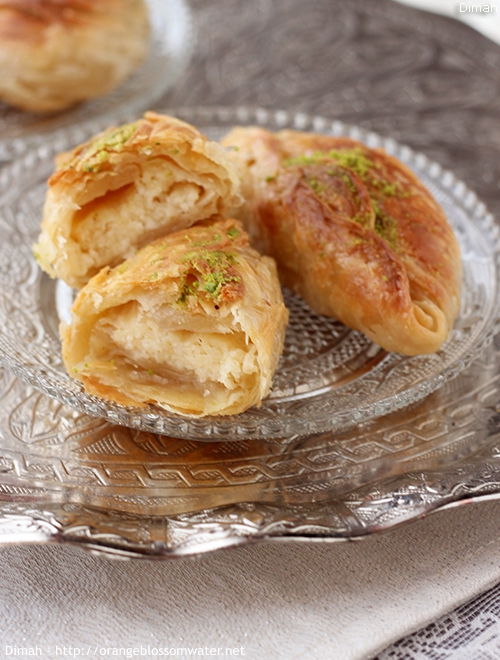
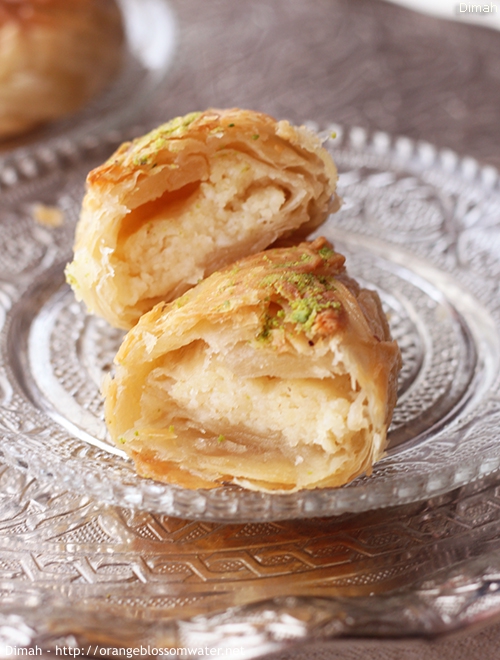
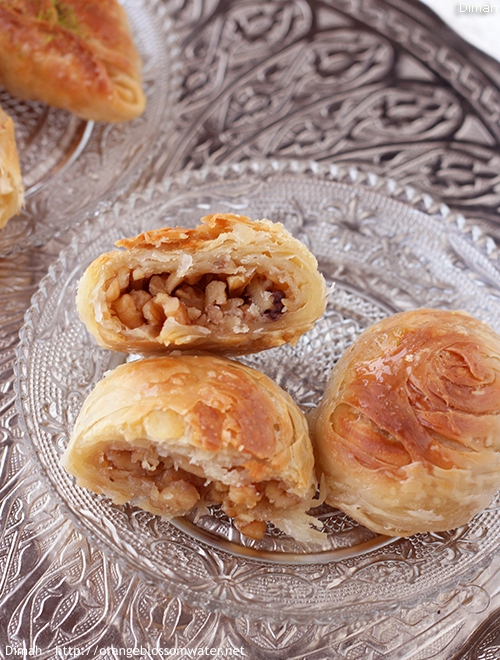
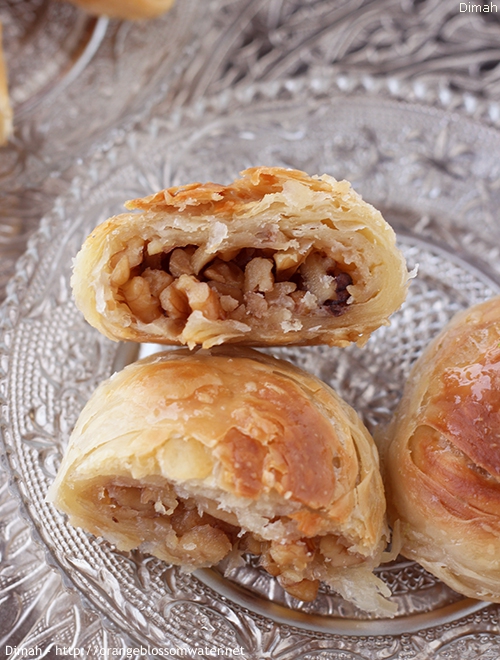
Sh’eibiyyat
From: Family Recipe / Servings:
PDF Text Only / Print With Images
| Dough
Sugar Syrup 690 g (3 cups) sugar 345 g (1 1/2 cups) water Less than 1/8 tsp lemon salt “citric acid” or lemon juice Qasheh Filling 100 g Qasheh 100 g Khabisah Khabisah 10 g (3/4 tsp) butter, melted 90 g (1/2 cup) medium semolina 30 g (2 tbsp) sugar 230 g (1 cup) milk Walnut Filling 100 g chopped walnuts, 12 g sugar 5 ml (1 tsp) water Garnish Ground Pistachio |
Ingredients for Sh’eibiyyat are: ‘Ajineh Mwarraqah, Qasheh “Qeshta”, chopped walnuts, and sugar syrup. Dough is used fresh or frozen, check the post ‘Ajineh Mwarraqah for all the details about it. If it is frozen, allow to thaw in the fridge for few hours then at room temperature. Do not leave it a room temperature for long time, otherwise ghee will melt, the dough should hold its shape. I used two sizes, large Sh’eibiyyat are made with pieces of dough weighs 50 g, small Sh’eibiyyat are made with pieces of dough weigh 35 g. Sugar Syrup Put 690 g (3 cups) sugar in a saucepan. Pour 345 g (1 1/2 cups) water over sugar. Dissolve sugar in water over high heat, and bring it to boil. Add less than 1/8 teaspoon lemon salt (citric acid) or lemon juice to sugar syrup, and boil for 5 minutes. Allow to slightly cool, then pour into a jug and set aside. Filling Qasheh Filling Sh’eibiyyat is filled with Qasheh “Syrian clotted cream made from sheep’s milk” that is available only in Hama, nothing can substitute the real taste of Qasheh. Measure 100 g Qasheh, and set aside. Khabisah If Qasheh is not available, this is a recipe of “Khabisah” to use it instead of Qasheh, but it won’t give the same taste. Ingredients for Khabisah are: butter, semolina, sugar and milk. Melt 10 g (3/4 teaspoon) butter. Add 90 g (1/2 cup) medium semolina to butter, stir with a wooden spoon until lightly toasted. Add 30 g (2 tablespoons) sugar to semolina, stir with a wooden spoon. Add 230 g (1 cup) full fat milk to semolina, stir with a whisk until semolina is cooked and thickened. Transfer cooked mixture “Khabisah” to a bowl, allow to completely cool. The total weight of Khabisah is 320 g. For the recipe, measure 100 g khabisah. For Qasheh as filling, there are three choices: – Use only Qasheh “Traditional Syrian clotted cream “. The amount for the recipe is 200 g. This is the traditional way. Sh’eibiyyat filled with Qasheh only are usually more expensive. – If Qasheh is not available, use only Khabisah. The amount for the recipe is 200 g. – If Qasheh is available but to make the filling lighter, use 100 g Qasheh with 100 g Khabisah. I did this. Add 100 g Khabisah to a bowl. Add 100 g Qasheh to Khabisah. Mix the two ingredients together until well combined. This is the first filling for Sh’eibiyyat. Set aside. Walnut Filling Measure 100 g chopped walnuts. Add 12 g sugar to chopped walnuts. Add 5 ml water to walnuts. Mix with a spoon until combined. This is the second filling for Sh’eibiyyat. Set aside. Assembly Bring the dough and the first filling “Qasheh mixed with Khabisah” Prepare aluminum baking sheet, no need to grease it. Take one piece of dough and gently press with your hand. This piece of dough weighs 50 g. Roll the dough with a rolling pin to a circle about 4.3 inch (11 cm) diameter with 0.2 inch (1/2 cm) thickness. Bring the first filling. Each piece of dough that weights 50 g will be filled with 25 g of Qasheh filling. Put 25 g filling in the middle of the dough and spread it. Fold the top of the dough to the middle and the other side over it. Put in the prepared baking sheet. I made Sh’eibiyyat with smaller pieces of dough. Take one piece of dough and gently press with your hand. This piece of dough weighs 35 g. Roll the dough with a rolling pin to a circle about 3.5 inch (9 cm) diameter with 0.2 inch (1/2 cm) thickness. Each piece of dough that weights 35 g will be filled with 17 g of Qasheh filling. Put 17 g filling in the middle of the dough and spread it. Fold the top of the dough to the middle and the other side over it. Put in the prepared baking sheet. Repeat with the other pieces of dough. I made 6 pieces of dough weigh 50 g and 4 pieces of dough weigh 35 g. Bring the dough and the second filling Chopped Walnuts. Take one piece of dough and gently press with your hand. This piece of dough weighs 50 g. Roll the dough with a rolling pin to a circle about 4.3 inch (11 cm) diameter with 0.2 inch (1/2 cm) thickness. Bring the filling. Each piece of dough that weights 50 g will be filled with 20 g of walnuts filling. Put 20 g filling in the middle of the dough. Fold the top of the dough to the middle, then the right side, then the left side, then the bottom side over them. Flip the prepared piece over so the seam is down, then put in the prepared baking sheet. I made Sh’eibiyyat with smaller pieces of dough. Take one piece of dough and gently press with your hand. This piece of dough weighs 35 g. Roll the dough with a rolling pin to a circle about 3.5 inch (9 cm) diameter with 0.2 inch (1/2 cm) thickness. Each piece of dough that weights 35 g will be filled with 14 g of walnut filling. Put 20 g filling in the middle of the dough. Fold the top of the dough to the middle, then the right side, then the left side, then the bottom side over them. Flip the prepared piece over so the seam is down, then put in the prepared baking sheet. Repeat with the other pieces of dough. I made 4 pieces of dough weighs 50 g and 3 pieces of dough weigh 35 g. Preheat the oven to 428°F (220 °C). Place the baking sheet in the oven (rack position the second from bottom), and bake for 12 minutes or until golden brown in color on bottom. I baked Sh’eibiyyat in the oven with the top burner on and bottom burner on, baked for 7 minutes on second rack from bottom then put it on bottom rack for 3 minutes, then returned to second rack with bottom burner off and kept the top burner on for 2 minutes. Take from the oven and keep on the baking sheet. Immediately pour cold sugar syrup over them. Garnish Sh’eibiyyat filled with Qasheh with ground pistachio. Transfer into serving plate. Serve Sh’eibiyyat hot, or warm, or at room temperature. |
Notes and Tips
Check the post ‘Ajineh Mwarraqah for all the details about the dough.
Sh’eibiyyat is filled with Qasheh “Syrian clotted cream made from sheep’s milk” that is available only in Hama, nothing can substitute the real taste of Qasheh. If Qasheh is not available, make the recipe of “Khabisah” to use it instead of Qasheh, but it won’t give the same taste.
For Qasheh as filling, there are three choices:
– Use only Qasheh “Traditional Syrian clotted cream”. This is the traditional way. Sh’eibiyyat sold filled with Qasheh only are usually more expensive.
– If Qasheh is not available, use only Khabisah.
– If Qasheh is available but to make the filling lighter, I did this.
I made two sizes of dough 50 g and 35 g to show you large Sh’eibiyyat and small Sh’eibiyyat.
– Sh’eibiyyat filled with Qasheh: I made 6 pieces of dough weigh 50 g and 4 pieces of dough weigh 35 g, and I used 200 g of Qasheh filling.
– Sh’eibiyyat filled with Walnut: I made 4 pieces of dough weigh 50 g and 3 pieces of dough weigh 35 g, and I used 100 g of walnut filling.
I did not use all the amount of sugar syrup.
Check my videos:
Making ‘Ajineh Mwarraqah
Making Sh’eibiyyat
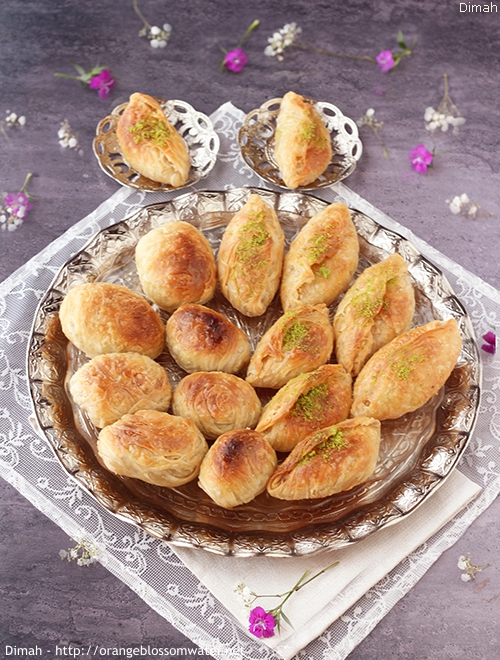
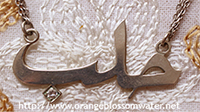
I never bake myself but this looks so delish I might just do that! I find Arab desserts extremely fascinating.
Nifty Noshing: I wish I can send you some! , thanks for stopping by and for your kind words!
Dimah! I have been pining for these for years and years; every time I go back to Aleppo, I try and consume as MANY of them as I can – a difficult feat when you’re trying to stay balanced!
Thank you so much for the recipe of the dough. I’ve made these using different pastries – both home-made and bought – including home-made croissant pastry, and although tasy it’s never been quite perfect. I’m now eager to try your recipe for the dough and make everyone homesick.
You’re right – the filling is never as good as the one you can find in Syria, but it’s close! I’ve also used Cornish clotted cream, which (I am a Londoner) is easily available here.
I’m loving this site, your recipes are all so familiar, and it’s a relief to see Syrian cuisine in a more authentic form. Most other sites either have Lebanese variations, or import additions that are usually delicious but aren’t quite what we grew up on and pine for.
L x
Lamia: Thank you so much for your lovely comment! I’m truly touched, you made my day :).
I’m glad you enjoyed the site and posts.
Thanks for coming by my blog, and I hope to see you around again soon.
I am planning to make these for Eid, I hope – I’ll let you know how the pastry turns out!!
Also hoping to make Lahma bil karaz… my absolute favourite dish, and an Aleppine speciality. You can’t get the cherries fresh here, but there’s an excellent French compote that does the job! Do you make it much?
Lamia: if you are planning to make these for Eid, so I suggest to half the recipe of the dough and try it before Eid, that allows you to practice and see the results.
Lahme Bil Karaz is not popular in Hama, I lived in Aleppo for a while and heard about Lahmeh Bil Karaz but never tried it.
I suggest for you this website http://parisalep.wordpress.com/ written by a lady from Aleppo but living in France, she is sharing Syrian recipes too and specially from Aleppo, the website is in French.
Hello Dimah, Ramadan Mubarak (near the end!) I hope you’ve been well.
I actually haven’t seen your replies to my comments until today. (!)
Thank you for the French link; it’s always enlightening to see how others outside Syria prepare the same recipes, because we often have to find alternatives for ingredients that aren’t readily available abroad.
I always make lahma bil karaz using my family recipe : )
Will hopefully be making more sh’eebiyyaat this Eid – I’ve settled for using a mixture of ricotta cheese and lebbeh for the filling, flavoured with orange blossom water. It’s light and close to the qashta.
Keep up the wonderful work
L x